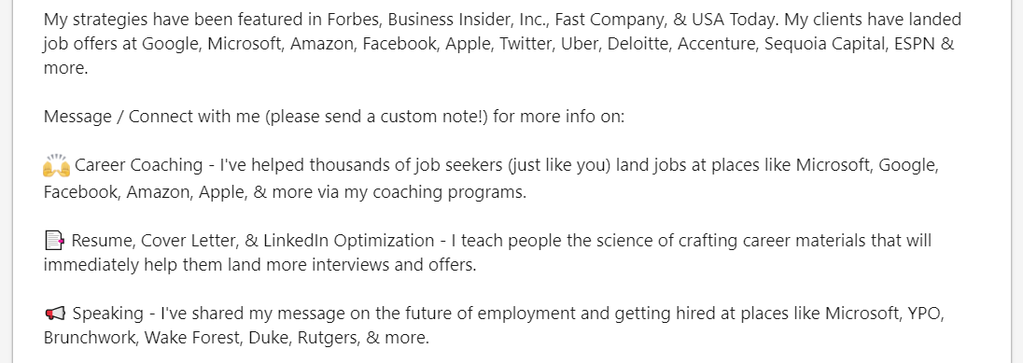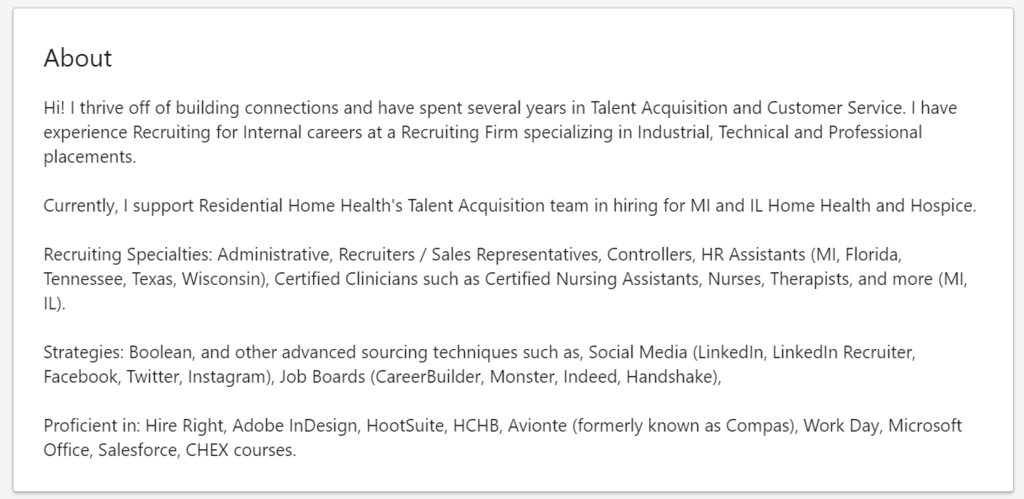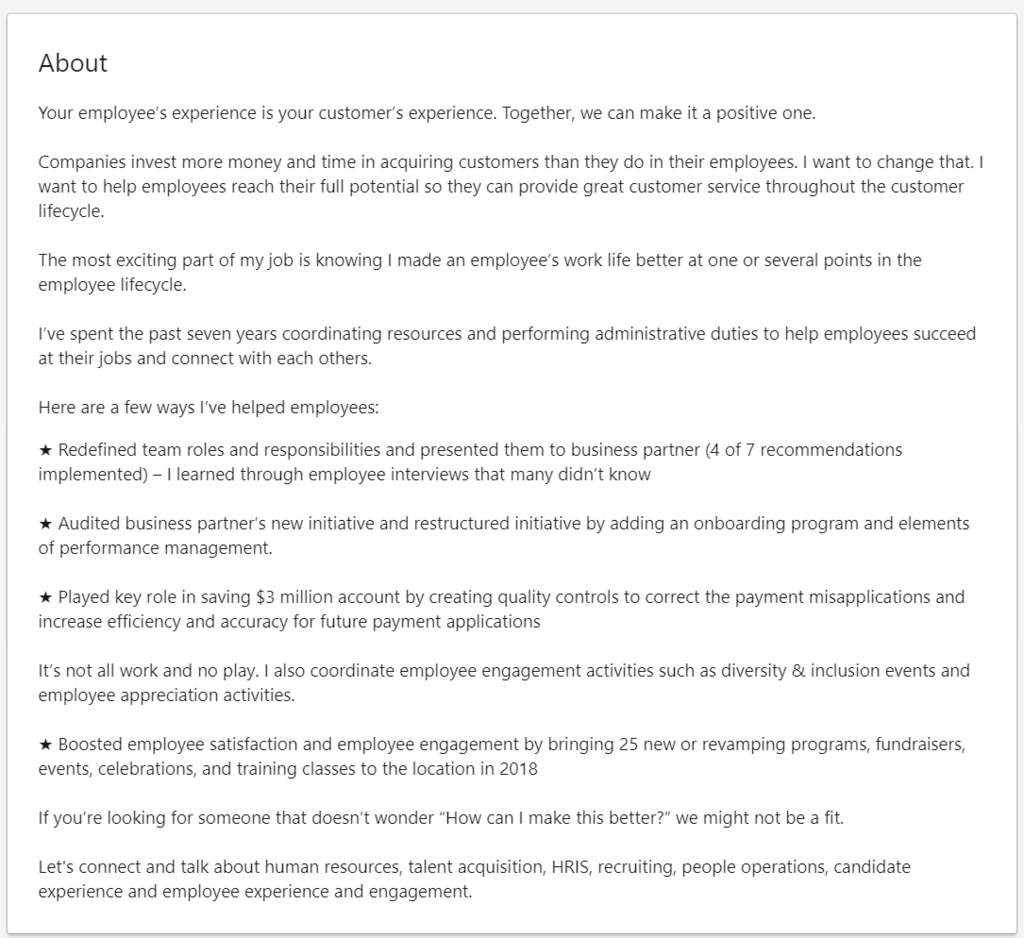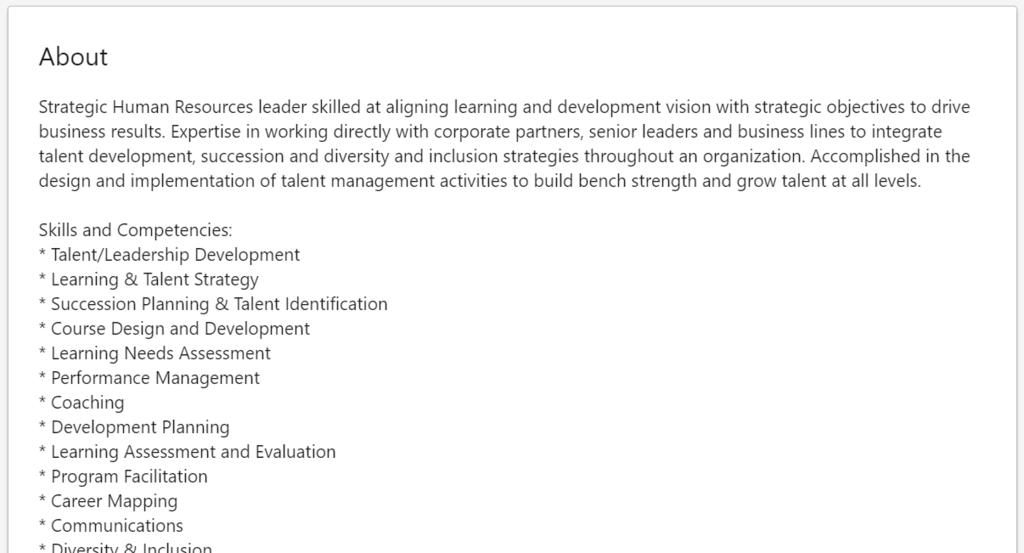
How to Write a LinkedIn Summary (5 Examples for Job Seekers)

Your LinkedIn “summary” is one of the first places recruiters and employers look on your profile.
And if you don’t impress them, they might quickly scroll past the rest of your profile and move on to someone else’s.
So here’s what you’re going to get in this article:
- 11-step checklist showing you how to write a great LinkedIn profile summary that gets you interviews
- Multiple LinkedIn summary examples and screenshots to help you write your own
- My #1 mistake to avoid when writing your LinkedIn summary as a job seeker
Let’s get started…
How to Write a Great LinkedIn Summary for Job Searching
1. Focus on demonstrating what you’ll do for an employer
Writing a great LinkedIn summary as a job seeker isn’t all that different from anyone else.
You want to catch the reader’s attention, tell your story, and communicate the value you’d bring to a company… all in a few paragraphs.
And just like with a LinkedIn headline, I don’t recommend making your focus on the fact that you’re actively seeking jobs.
No employer wants someone solely based on the fact they’re actively looking for a job.
In your LinkedIn summary, you should focus on showing the value you’ll bring to a new organization and why employers should want you on their team.
THAT’S why a recruiter or employer will contact you on LinkedIn. Not because you say, “Actively seeking positions.”
If you want more information about why this is true, I go further into it in this article on LinkedIn headlines.
2. Emphasize hard skills first and foremost
While it’s okay to put a few soft skills on your LinkedIn profile, those aren’t going to win you the interview. Employers look for hard skills on your LinkedIn profile and your resume when deciding whether to interview you.
They’ll try to measure your soft skills (like whether you’re hard-working, motivated, honest, etc.) in the interview!
So focus at least 80% on hard skills.
Here’s an example of an opening line I saw on a real LinkedIn summary/about section, that focuses too heavily on soft skills:
Dynamic, creative, motivated, and adaptable social media and branding enthusiast…
The problem with this is that it emphasizes soft skills first, which is not what employers care about on your profile.
This person would be much better off saying:
Social media and branding enthusiast with a proven track record of…
That way, their hard skills and expertise appear first. (And then, they should ideally go on to name more specific hard skills like “Facebook advertising,” “Content marketing,” etc.)
3. Include numbers and data
One of the best ways to prove you’ll be valuable in a job is to show what you’ve done in past jobs. And nothing demonstrates this better than real results, numbers, and data.
Percentages, dollar amounts, headcounts (if you managed or trained people, etc.)
Putting data like this on your LinkedIn profile summary is going to grab the reader’s attention and help convince them that you’re someone they should interview.
You’ll see how to put data in a LinkedIn profile summary in some of the examples coming up soon in this article.
4. Include keywords for the type of job you want
This is where you can adjust your LinkedIn summary specifically for your job search.
Look at job descriptions for the positions you want to apply for, and notice what some of the most common keywords are.
Then include a few of these keywords in your LinkedIn summary/about section to show employers you’re a good fit for their position.
You can also use your “Skills” section to put more keywords lower down on your LinkedIn profile.
5. Make your opening sentence as interesting as possible so employers click “see more”
The reader isn’t going to see your full “About” text in your LinkedIn profile summary at first.
They’ll see a small snippet and can click “see more” if they’re interested. So we want to get them to click!
Here’s an example of a LinkedIn summary section that caught my eye and made me want to see more. It’s a bit different, but it did its job – grabbing my interest and getting me to stop scrolling past!

6. Show passion for your work
After you’ve demonstrated hard skills, past results, data, accomplishments, etc., it’s time to show some passion for your work.
Find a way to show that you’re excited about what you do and you’ll attract more employers.
Employers don’t just look at ability and experience. They want to hire someone who’s going to be excited about coming into work each day.
So think about what motivates you and show a bit of that on your LinkedIn profile summary.
7. Show some personality
Showing some personality can also help you stand out and be more memorable, which can get you more interviews.
For example, you might begin your LinkedIn profile summary by saying:
“Hi, thanks for checking out my profile! I’m a digital marketer with 4 years of experience in advertising, social media management, and obsessing over coffee! (Ask me about my own homemade cold-brew!)
That last piece has nothing to do with work but shows who you are as a person.
This will make your summary on LinkedIn stand out from all the job seekers and people who keep it 100% work-related. And if a recruiter or hiring manager is a coffee lover, they might ask you about this.
So showing some personality or even humor in your LinkedIn summary can be a great conversation-starter.
8. Utilize white space and small paragraphs to make your LinkedIn summary easier to read
Hiring managers and recruiters don’t want to read giant blocks of text with 10 sentences per paragraph. (In fact, this is true for everyone online.)
So make sure you relatively short paragraphs with a white space in between each. This will make your Summary section much easier to read.
If you’re not sure what good spacing looks like, take a look at the text in this article you’re reading right now. Notice how it’s spaced out and doesn’t have any massive, 10-sentence paragraphs. That’s by design, and we do it throughout the whole site to make it more pleasant to read.
Try to emulate that type of spacing in your profile summary. You’ll see this in all of the LinkedIn summary examples coming up in the second half of this article, too.
9. Use special characters to further stand out
To get noticed and separate yourself from other job seekers, consider using bullets, checkmarks and maybe even emojis in your formatting.
Just don’t go overboard. It looks tacky when someone’s LinkedIn summary is full of 20 red and pink emojis (I’ve seen this, unfortunately).
Here’s an example of a GOOD amount of emojis and special characters/formatting:

Credit for this profile goes to Career Coach Austin Belcak on LinkedIn.
You’ll notice this profile also has great spacing and isn’t too “dense,” like we talked about in the previous tip.
10. Add relevant attachments
After you’ve written a great LinkedIn summary, you can also add attachments like PDFs, videos, and images.
These attachments will appear in the small “snippet” that people see before clicking “see more” on your summary, which will help you get noticed.
Don’t just attach a copy of your resume, though. I don’t recommend doing this anywhere on your LinkedIn profile. It’s better to make employers ask for that! These attachments should be portfolio pieces, other examples of past work, awards, testimonials, case studies, certifications, etc.
Here’s an example of how attachments look in a LinkedIn summary/about section:

11. Include a “Call to Action” at the end
This is something most job seekers don’t do, yet is highly effective.
Did you know that simply asking someone to do something increases the chances they’ll do it?
So at the end of your summary, ASK them to contact you if they think your background will fit an opportunity they have.
You might say:
“If any of the above sounds interesting and you think it would be a potential fit to work together, send me an invitation to connect and let’s talk!”
Note: This is the only place where I’d recommend indicating that you’re actively looking for jobs in your LinkedIn summary. (I mentioned earlier not to waste space on the rest of your summary with this, and to focus on showing how you’ll bring value to your next employer instead).
5 LinkedIn Summary Examples for Job Seekers (Unemployed or Employed)
Now that we’ve gone through how to write a great LinkedIn profile summary step-by-step, let’s look at some of the best LinkedIn summary examples for job seekers.
These are effective LinkedIn summary examples if unemployed or employed. It doesn’t matter. The idea is the same – to show employers how you’d help their organization and why they should want to interview you.
LinkedIn Summary Example #1

This LinkedIn summary example is well-spaced (no big blocks of text), and includes a ton of keywords showing what this person is best at.
And that’s the type of information that can get you a job interview with employers who need the skills you highlight.
LinkedIn Summary Example #2

This example also has great spacing and uses some unique formatting (star-shaped bullet points) to attract attention.
This person’s LinkedIn summary also does a good job of showing some passion for the work they do (where they say, “The most exciting part of my job is….”)
That phrase is a great way to show that you care about what you do and enjoy your work, which is something employers care a lot about when they decide who to hire!
LinkedIn Summary Example #3

This is an example of a shorter LinkedIn summary. You don’t NEED to have a massive summary section.
Although, I would add one paragraph to this just to provide a bit more detail.
However, even in this one small paragraph, this summary does a good job of including multiple hard skills/keywords like HTML, CSS, etc.
LinkedIn Summary Example #4

This is another LinkedIn summary example that uses unique formatting to grab the reader’s attention.
Instead of putting everything in paragraph format, this person put one brief introductory paragraph, and then bullet points with their top hard skills/keywords.
This will help you get found by recruiters who are searching for talent on LinkedIn.
LinkedIn Summary Example #5 (For College Students and Recent Graduates):

This LinkedIn summary example for graduates does a good job of showing your current situation (about to graduate, just graduated, etc.), and then indicating what type of job you want.
I like this idea of saying, “I’m looking forward to acquiring a job in the __ community.” – It sounds so much better than just saying, “Actively seeking __ opportunities”.
This profile also includes a few good keywords like HR, Human Resources, etc.
If I were editing this LinkedIn summary, I’d recommend adding one additional paragraph to show more of what you’ve done/accomplished in your academic studies, and maybe including a few more keywords (like sub-topics within HR or Business Administration that you studied).
You can also use the general tips throughout this article to write a great LinkedIn summary as a college student or graduate. You don’t need to follow this one example.
How Long Should a LinkedIn Summary Be?
Your LinkedIn summary should be between 2-8 paragraphs. If you’re viewing your summary on a full-size computer screen, the entire summary text should fit on the screen without scrolling (or should come very close, if not). If it’s longer than this, considering editing your summary to only include the most relevant, important info.
Showing detail is good.
As a recruiter, I don’t love the one-line LinkedIn summaries that just say something like, “life-long learner” without sharing any detail about what value you bring to a company.
But at the same time – nobody wants to read a book’s worth of text in your LinkedIn profile summary, either. So it’s about finding the perfect balance.
If your LinkedIn profile summary is the same length as any of the examples we looked at above, you’re fine.
Follow These LinkedIn Summary Tips for an Easier Job Search
If you follow the tips above, you’ll have a great LinkedIn summary that grabs the reader’s attention and gets you job interviews!
To get started, go open a blank document and begin drafting your own summary based on the examples and steps we looked at. Then paste your new summary into your LinkedIn profile after you’re happy with what you have!